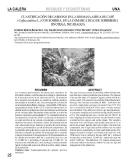Cuantificación de carbono en la biomasa aérea de café (Coffea arábica L.) con sombra, en la Comarca Palo de Sombrero, Jinotega, Nicaragua
Description
7 páginas: 1 ilustración, 2 tablas. Documento en español con resumen en inglés. 14 referencias bibliográficas
Abstract
Los sistemas agroforestales son potenciales sumideros de dióxido de carbono, contribuyendo así a mitigar el calentamiento de la tierra por efecto de las emisiones de C02 . El propósito de la presente investigación, es cuantificar carbono orgánico almacenado en sistema de café. Esta investigación se desarrolló en la hacienda Santa Maura, Jinotega., altitud 1000–1250 msnm, temperatura promedio de 19 a 23º C, suelos del tipo molisol. Se identificaron tres tipologías de cafeto de estudio que se diferencian por su variedad, edad y densidad de establecimiento. Se realizó un muestreo sistemático, intensidad del 2 %. La unidad de muestreo fue una parcela circular de 250 m2 , en cada parcela de muestreo se tomó un árbol de eje central, procediendo a inventariar e identificar las especies de árboles y cafeto. Se midieron la altura total, altura fuste limpio, diámetro a la altura del pecho del que muestrea, pesos húmedo y seco de los diferente componentes. En los depósitos aéreos de cafetos y especies de sombra, se estimó la biomasa y contenido de carbono. En la tipología dos se encontró el mayor promedio de C almacenado con 19.86 tonelada métricas de carbono por hectárea (tMC ha-1), seguido del tipo tres, con 11.12 tMC ha-1 y por último, el tipo uno con 5.5 tMC ha-1. La diferencia de contenido de C entre tipología, está directamente ligado a la densidad, especie de árbol de sombra, edad y manejo de la plantación. The Agro forestry systems are potential carbon dioxide sink, contributing to reduce greenhouse gas emissions. The purpose of the present study is to quantify organic carbon stored in a coffee system. This research was carried at Santa Maura farm, Jinotega. The farm has an altitude of 1000 - 1250 above the sea level; temperature average is between 19 to 23 ºC. The soil is classified as mollisols. Three types of coffee systems were identified. They differ on varieties, age and plan density. A systematic sampling was performed using sample intensity of 2%. The sampling unit was a circular plot of 250 m². In each sampling plot a plan inventory was performed in order to identified tree species and coffee plants. The variables measured were: total height, stem height, diameter at 1.5 m above the ground, and dry and fresh weight of the different components. Dry weight and carbon content were recorded from the above ground parts of coffees and shade species. The biggest average of storage C was found at the type two, with 19.86 metric ton of carbon by hectare (tMC ha-1), followed by type three which had 11.12 tMC ha-1, and finally type one with 5.5 tMC ha-1. The difference of C content among types is directly linked to the density, shadow tree species, age and management of the plantation.
Keywords
Publisher
CATIE, Turrialba (Costa Rica)
URI (Permanet link to cite or share this item)
https://repositorio.catie.ac.cr/handle/11554/5993Collections
- Publicaciones y documentos [4434]


